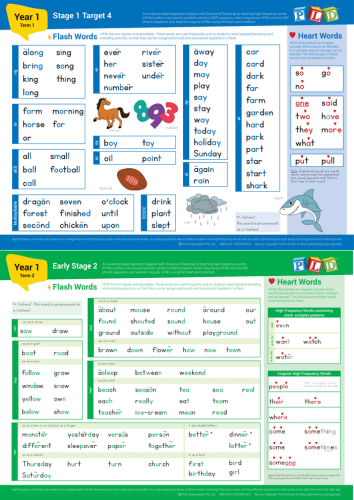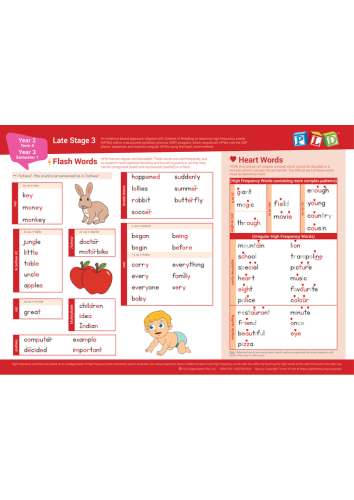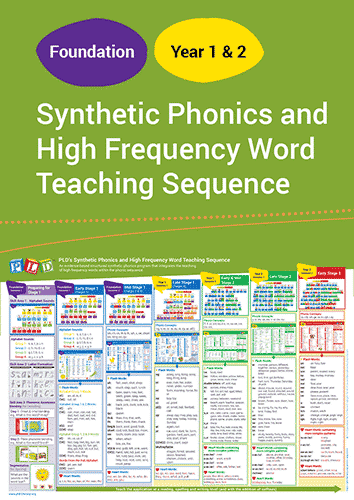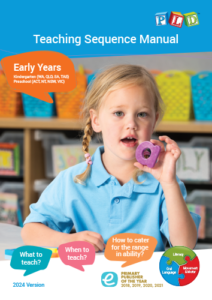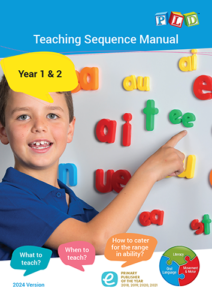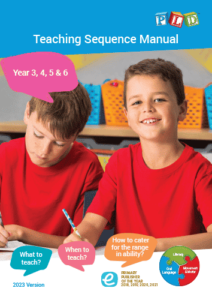PLD’s unique approach scaffolds children to learn more high-frequency words with less effort by teaching the right words at the right time and in the right way.
Following an extensive literature review in 2020, PLD’s approach to high-frequency words, also called HFW, was upgraded. If you would like to read more about the body of research largely conducted by cognitive scientists, go to The Science of Reading: A Defining Guide. Moving forward, PLD’s approach to high-frequency words addresses three common issues:
- Teaching high-frequency words in the order of frequency is important, however the complexity and the composition of the words require a greater level of consideration for an early literacy learner.
- Applying a set of high-frequency words to a year level. Not only does administering sight word lists e.g. the first 100 words in Foundation, the second 100 in Year 1 etc not take into account the developmental level that students are operating, this approach does not align with the class’ phonic and phonemic awareness knowledge.
- The existing evidence-base consistently argues for high-frequency words to be presented within a SSP program. Although this is repeatedly stated, it is unclear how the amalgamation of phonics and high-frequency words should actually occur.
The Process
It is in direct response to issues such as the three listed above that PLD embarked on the following process to align instruction to the evidence-base.
Step 1: Amalgamation of all of the words that occurred within a range of high-frequency word lists commonly used in Australia.
The collections differed in terms of how and when each list was created. The lists also differed in terms of the number of words contained on each list. For example, Fry’s 300 words reflect the most common words in children’s literature and the Oxford 500 list contains the words commonly used by Australian children in their writing. For some lists such as the Magic list, it was difficult to source the origins.
The amalgamation of the word lists totalled 574, along with a number of similar words differing only by the addition of a suffix to the base word.
Many of the words appeared on every high-frequency words list, with approximately 60% of the words appearing on at least two of these lists.
Step 2: The expanded high-frequency word lists were organised based on their location within PLD’s SSP progression.
What this revealed was that the vast majority of the high-frequency words could be explicitly taught within PLD’s Stages 1, 2 and 3. To assist the teaching of these words in Stages 1 and 2, the high-frequency words were linked to early, mid or late phonic concepts within these stages.
Step 3: The remaining irregular high-frequency words or complex words (with sophisticated or advanced code) were clustered according to spelling patterns and frequency of occurrence.
What many teachers will find surprising is that it is possible with the majority of irregular high-frequency words. All words were then structured using techniques based on advances in orthographic mapping theory, or the ‘speech-to-print’ approach.
Step 4: All words were colour coded to illustrate the relationship between the sound and phonic structure.
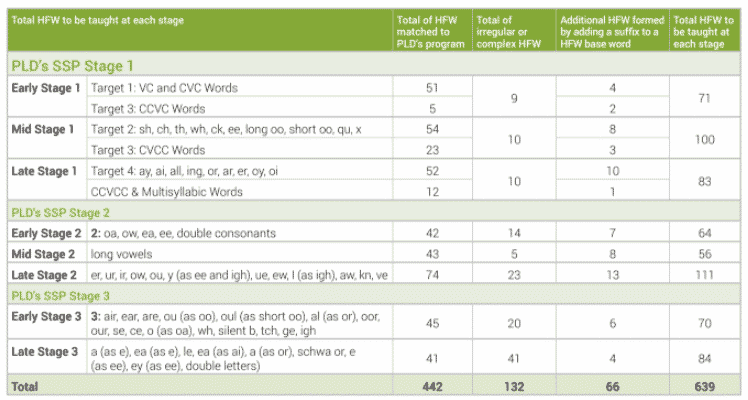
An additional 75 high-frequency words can be taught across Stages 1-3 by teaching the addition of suffixes. For example, in Stage 1 children are taught the high-frequency words ‘play’. Additional high-frequency words ‘playing’ and ‘played’ can be easily taught by adding a suffix to the base word.
The Result: An Integrated Phonic & high-frequency words Sequence
Go to the SSP Teaching Overview page for more about PLD’s teaching sequence. The charts below are also valuable for classroom teachers. Download the set for your year level.
Teaching Sequence Manuals
PLD’s teaching sequence manuals are free to download. They were written to support our professional learning and SSP teaching resources.
Additional Reading
Our most popular article: Top Tips to Remove the Confusion Around Sight Words
References
- Bianca, J. L, Scull, J. & Ives, D. (2008) The Oxford Wordlist Top 500. Oxford University Press.
- Magic 300 Words. www.magicwords.com.au
- Kilpatrick, D. A. (2016) Equipped for Reading Success. Casey & Kirsch Publishers, New York.
- Dolch, E. W. (1936). A basic sight vocabulary. The Elementary School Journal, 36(6), 456–460.
- Education Department of South Australia. (1984). Salisbury word list. In the Education Department of South Australia (Ed.) Spelling R–7 Language Arts (pp. 73–80). Adelaide: Education Department of South Australia.
- Fry, E. (1980). The new instant word list. The Reading Teacher, 34(3), pp. 284–289.
- Fry, E. (1999) 1000 Instant Words, Teacher Created Resources Inc. Laguna Beach Educational Books, USA.
- PLD’s 7 top tips to remove the confusion around sight words.
Notice:
Like a range of other Science of Reading programs, PLD applies the concept of HEART WORDS to irregular HFW’s. However PLD has adapted the commonly used application of HEART WORDS to also include orthographic mapping theory (and colour coding illustrating the relationship between phonemes and letters). PLD applies colour and the heart over the aspect (or aspects that are irregular or complex) for young literacy learners. These irregular (or complex aspects) and needed to be learned by heart.
Useful Blogs Referencing Heart Words:
- https://campinginprimary.com/orthographic-mapping-heart-words/
- https://theearlylearningplace.com/2021/10/15/what-are-heart-words/
- https://www.reallygreatreading.com/heart-word-magic
Small Sample of Other Programs Using Heart Words:
- Little Learners Love Literacy Free Downloads (littlelearnersloveliteracy.com.au)
- Reading Rockets A New Model for Teaching High-Frequency Words | Reading Rockets



 print
print
